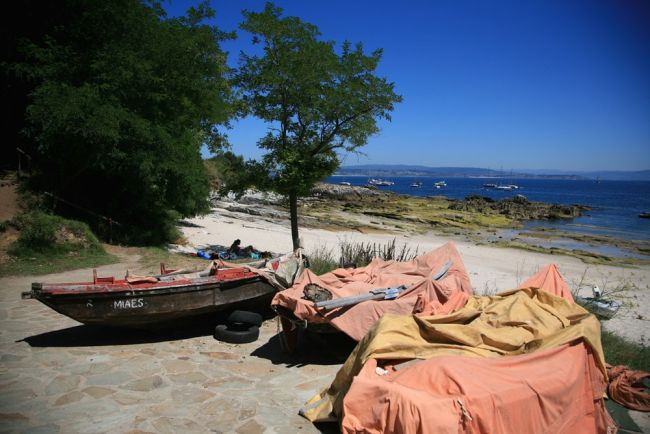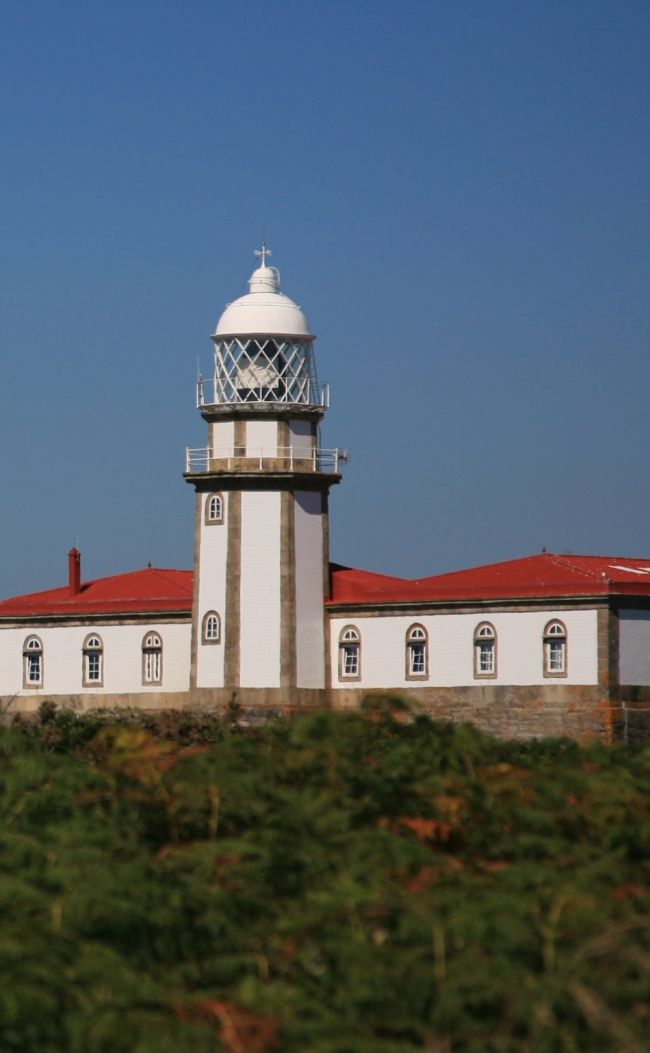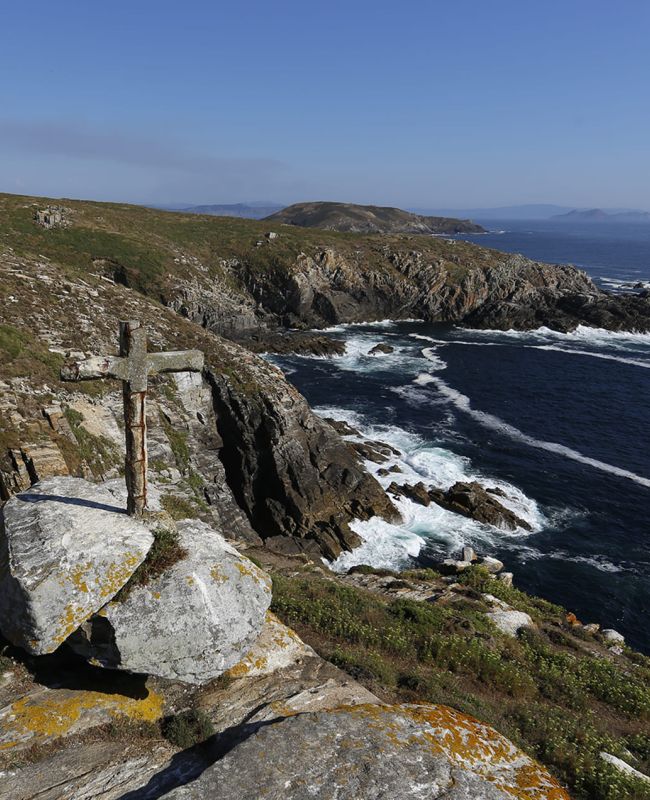Historia de la Isla de Ons
Los primeros útiles líticos que aparecen en el archipiélago de Ons son del Paleolítico (se conservan en el Museo Provincial de Pontevedra), pero los primeros asentamientos encontrados datan de la Edad de Bronce.
Conoce la historia de la Isla de Ons
El castro encontrado en Canexol (Castelo dos Mouros) todavía está sin excavar, y conserva la estructura defensiva circular. En el norte de la isla se halló otro castro (A Cova da Loba), de dimensiones más pequeñas. El primero de los castros fue romanizado, en torno al siglo I, aunque apenas se han encontrado vestigios de la época (la falta de prospecciones arqueológicas imposibilita la existencia de un registro). Los romanos bautizaron a la isla de Onscomo insula Aunios, como cita Plinio ‘el Viejo’ en su descripción de la Península Ibérica.

Islas de Ons
en la Edad Media
Pero hasta la Edad Media no se menciona el archipiélago de Ons con más frecuencia. En el año 899 aparece escrito en la donación de la isla que realiza el rey Alfonso III al obispo de compostelano, y cuyo Cabildo pasa a tener posesión hasta el s. XVI. La existencia de un sepulcro antropomorfo (Laxe dos Cregos) en la Area dos Cans hace creer que existió un convento, o algún eremita; según la tradición, esta tumba -visible con marea baja- es la de un monje que habitó esta isla.
En el s. XVI el archipiélago de Ons pasó a manos de una familia de nobles, los Montenegro. A finales de este siglo comenzó el asedio de corsarios ingleses y piratas, con Francis Drake a la cabeza, que terminó con la huida de los isleños a la costa. Durante la Guerra de la Independencia se construyeron dos baterías, el Castelo das Rodas (al norte) y la fortaleza de Pereiró (al sur), pero poco se conservan de ellas, pues la piedra se utilizó para la construcción de las nuevas viviendas. La creación de la fábrica de salazón de Valladares (conocida como O Almacén) sí atrajo definitivamente gente de Bueu y Cangas a la Isla de Ons, y que harían de la pesca su actividad económica principal.
En la década de 1920 las islas se repueblan con pinos para explotar la madera en la construcción de barcos. En 1929 Manuel Riobó compró el archipiélago de Ons, y ocupó la fábrica de salazón para construir un secadero de congrio y pulpo y comercializarlo. El heredero se suicidó por sus ideas republicanas en el comienzo de la Guerra Civil y dejó la isla de Ons sin gestión directa. El gobierno franquista -en aras de la defensa nacional- expropió las islas en 1940 con la intención de instalar una base de submarinos, que nunca llegaría a constituirse. A la guerra le siguió la hambruna, acentuada por la propia situación geográfica y socioeconómica de la isla; sin embargo la población no dejó de crecer (en 1955 Ons llegó a tener censados 530 habitantes). En este periodo se dota a la isla de escuelas e iglesia.
Pero las duras condiciones de vida (falta de infraestructuras o carencia de un puerto) motivaron el despoblamiento en apenas 20 años, a la par que comenzaba a desarrollarse una incipiente actividad turística. Muchos isleños sólo mantendrán una residencia temporal. En la actualidad, la isla de Ons es la única de las Islas Atlánticas con población estable.
A lo largo de estos siglos, los colonos de la isla de Ons pagaban rentas al Arzobispo, primero, y a las familias de Montenegro y Valladares, después. Todavía en la primera mitad del s. XX los isleños pagaban rentas por sus viviendas a la familia Riobó, y además estaban obligados a venderles todo el pulpo que pescaban. Y aunque actualmente no se pagan rentas, los isleños se siguen considerando colonos porque las casas donde habitan y las tierras no son suyas.
En las últimas décadas del s. XX el archipiélago de Ons pasó por las manos de varios organismos estatales (el IRYDA o el ICONA), hasta que en 1982 es transferida a la Xunta de Galicia, y el 1 de julio de 2002 se integra dentro el Parque Nacional Marítimo-Terrestre de las Illas Atlánticas de Galicia. Para evitar agresiones medioambientales se han adoptado varias medidas de protección que se unen a la figura del Parque: en 2001 la Isla de Ons se demarcó como ZEPA [Zona de Especial Protección para las Aves]; en 2004, el Complejo Intermareal Ons-O Grove, fue declarado Lugar de Importancia Comunitaria; también en 2004, Zona de Especial Protección de los Valores Naturales; y Zona OSPAR (en 2008).

Los núcleos de población
de la Isla de Ons
La población de la Isla de Ons fue bastante densa en el pasado, y las edificaciones se distribuyen por la parte oriental -más recogida- desde los páramos hasta la costa. Hay 9 aldeas que estadísticamente están agrupadas en un solo núcleo, Ons:
- O Curro: es la aldea más poblada (se puede considerar la capital de la isla), está urbanizada y en ella se concentran el puerto, los restaurantes y bares, la tienda y la iglesia.
- O Caño: es la continuación de O Curro, por la pista que sube al faro.
- O Cucorno: es la aldea más extensa y más alta de la isla, ocupa la falda del monte donde está el faro.
- O Laverco: otra aldea alta, situada junto a O Cucorno.
- O Centolo (o Sentulo): la más septentrional de todas, con cinco casas situadas en una zona bastante alta.
- Melide: son tres casas que están yendo hacia el faro, muy cerca de O Centolo.
- A Chan da Pólvora: media docena de casas algo desviadas de la pista que sube al faro. Aquí se ubica el camping de la isla.
- Canexol: situada en la ribera del mar, hacia el sur de la isla, donde está el cementerio.
- Pereiró: es la más meridional de la isla, también de las más grandes, situada en uno de los más fértiles de la isla.
La Isla de Ons tiene un poblamiento estacional, y es muy bajo el número de isleños que permanecen en ella todo el año. Ya desde primavera, los vecinos que emigraron al continente regresan para pasar la temporada estival en sus casas. Esto, unido a los cientos de visitantes y campistas que se acercan al archipiélago, confirma que la población supera el medio millar de habitantes.

La vida en la Isla de Ons
La pesca siempre fue la actividad económica principal de los isleños y se realizaba en embarcaciones tradicionales, de las que todavía quedan algunas. La dorna es pequeña, de madera de proa alta y curva, quilla profunda y se mueve a remo, aunque también puede portar vela. La gamela es más plana, con la popa y el fondo rectos, que la hacen más manejable en el interior de la ría de Pontevedra. Las artes de pesca que se han empleado en estas embarcaciones para pescar pulpo, nécora y otros mariscos han sido el palangre (un cabo que se extiende en la mar y que tiene varios anzuelos) y las nasas (jaulas donde se pone un cebo y las presas entran sin poder salir).
Y mientras que la pesca proporcionó ganancias (se vendía en las lonjas de Bueu y Cangas), la agricultura y la ganadería completaban la alimentación y los ingresos familiares. En la isla de Ons había cultivos de centeno, habas maíz, patata y trigo, que se trabajaban después de venir de pescar.
Leyendas y supersticiones
en la Isla de Ons
En la isla de Ons existen muchas leyendas que se entremezclan con las creencias y tradiciones populares de Galicia. Y es que el aislamiento y la falta de servicios han generado una cultura popular única, donde destaca el conocimiento sobre plantas medicinales, pero también la creencia en mitos y supersticiones. La Santa Compaña (procesión de almas en pena que anuncian la muerte) es un buen ejemplo del arraigo que tiene algunas supersticiones. Se dice en que en Ons entra por punta Centolo -proveniente de Noalla- y que tras dejar aviso desaparece por el cementerio.
Otra de las más comunes es el mal de ojo. En Ons se dice que para echar mal de ojo a alguien hay que ir a Beluso, traer un sapo, meterle un trozo de ropa de esa persona en la boca y conjurarlo. Para esto hay que ir a la playa, hacer 18 bolas de algas, poner mitad a la derecha y la otra mitad a la izquierda, tirar al mar las nueve de la derecha recitando «Ondas do mar sagrado / Tirame o aire de morto / de vivo ou escomulgado», y luego dejar secar en la lareira de casa las otras nueve, para acabar tirándolas en el mar.
También se dice que en el Buraco do Inferno (una sima de 5 metros de diámetro y 40 de profundidad situada en el sur) se oyen los lamentos de las almas que sufren tormento por sus pecados, unos lamentos que se oyen cuando hay vendaval y cuyo origen está en el golpeo del mar contra la roca y el sonido de los araos que anidaban en su interior. Además, la leyenda del toro dice que un astado con cuernos de oro nos protege del “mundo de los muertos”.

Patrimonio construido en la Isla de Ons
Son varios los elementos patrimoniales que podemos visitar en Ons. El más importante es el faro de Ons, uno de los más grandes y de mayor alcance en España. Está situado en O Cucorro, en la parte más alta de la isla, y es obra del arquitecto Rafael de la Cerda, quién construyó otro idéntico en la illa de A Rúa. Se encendió por vez primera en 1865, se revistió con azulejos en 1932, y fue de los últimos faros de petróleo a presión -con los de Sálvora y As Sisargas- que existieron, ya que partir de 1990 funcionó con energía fotovoltaica.
Otros puntos de interés desde el punto de vista patrimonial son las baterías en ruinas (la de As Rodas al norte del muelle y la do Castelo al sur), el castro de Canexol y el castro de A Cova, el viejo cementerio de Canexol (con más de 200 años de antigüedad) y la moderna iglesia de San Joaquín, seguramente construida sobre otra más antigua.